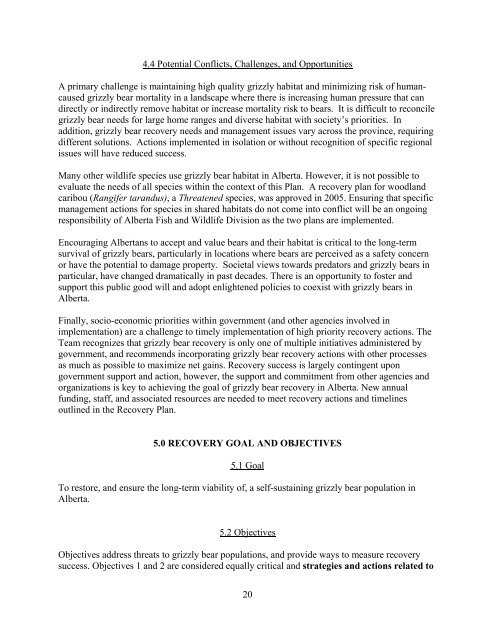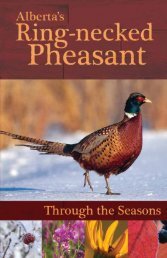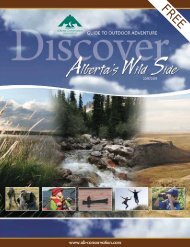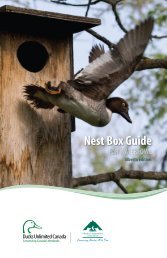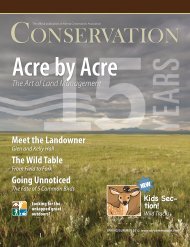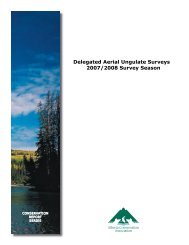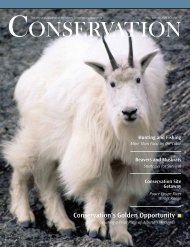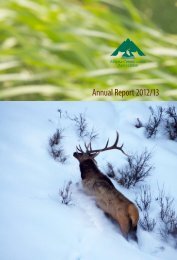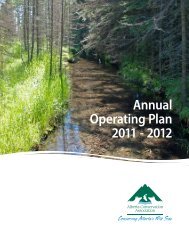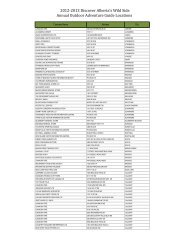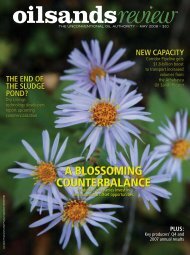Alberta Grizzly Bear Recovery Plan 2008-2013 - Alberta Sustainable ...
Alberta Grizzly Bear Recovery Plan 2008-2013 - Alberta Sustainable ...
Alberta Grizzly Bear Recovery Plan 2008-2013 - Alberta Sustainable ...
Create successful ePaper yourself
Turn your PDF publications into a flip-book with our unique Google optimized e-Paper software.
4.4 Potential Conflicts, Challenges, and Opportunities<br />
A primary challenge is maintaining high quality grizzly habitat and minimizing risk of humancaused<br />
grizzly bear mortality in a landscape where there is increasing human pressure that can<br />
directly or indirectly remove habitat or increase mortality risk to bears. It is difficult to reconcile<br />
grizzly bear needs for large home ranges and diverse habitat with society’s priorities. In<br />
addition, grizzly bear recovery needs and management issues vary across the province, requiring<br />
different solutions. Actions implemented in isolation or without recognition of specific regional<br />
issues will have reduced success.<br />
Many other wildlife species use grizzly bear habitat in <strong>Alberta</strong>. However, it is not possible to<br />
evaluate the needs of all species within the context of this <strong>Plan</strong>. A recovery plan for woodland<br />
caribou (Rangifer tarandus), a Threatened species, was approved in 2005. Ensuring that specific<br />
management actions for species in shared habitats do not come into conflict will be an ongoing<br />
responsibility of <strong>Alberta</strong> Fish and Wildlife Division as the two plans are implemented.<br />
Encouraging <strong>Alberta</strong>ns to accept and value bears and their habitat is critical to the long-term<br />
survival of grizzly bears, particularly in locations where bears are perceived as a safety concern<br />
or have the potential to damage property. Societal views towards predators and grizzly bears in<br />
particular, have changed dramatically in past decades. There is an opportunity to foster and<br />
support this public good will and adopt enlightened policies to coexist with grizzly bears in<br />
<strong>Alberta</strong>.<br />
Finally, socio-economic priorities within government (and other agencies involved in<br />
implementation) are a challenge to timely implementation of high priority recovery actions. The<br />
Team recognizes that grizzly bear recovery is only one of multiple initiatives administered by<br />
government, and recommends incorporating grizzly bear recovery actions with other processes<br />
as much as possible to maximize net gains. <strong>Recovery</strong> success is largely contingent upon<br />
government support and action, however, the support and commitment from other agencies and<br />
organizations is key to achieving the goal of grizzly bear recovery in <strong>Alberta</strong>. New annual<br />
funding, staff, and associated resources are needed to meet recovery actions and timelines<br />
outlined in the <strong>Recovery</strong> <strong>Plan</strong>.<br />
5.0 RECOVERY GOAL AND OBJECTIVES<br />
5.1 Goal<br />
To restore, and ensure the long-term viability of, a self-sustaining grizzly bear population in<br />
<strong>Alberta</strong>.<br />
5.2 Objectives<br />
Objectives address threats to grizzly bear populations, and provide ways to measure recovery<br />
success. Objectives 1 and 2 are considered equally critical and strategies and actions related to<br />
20


